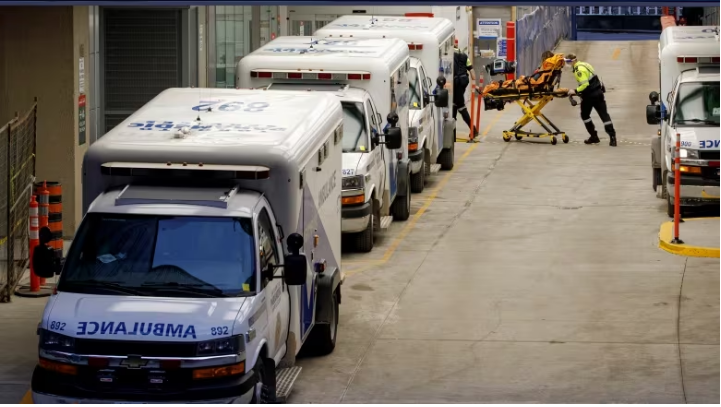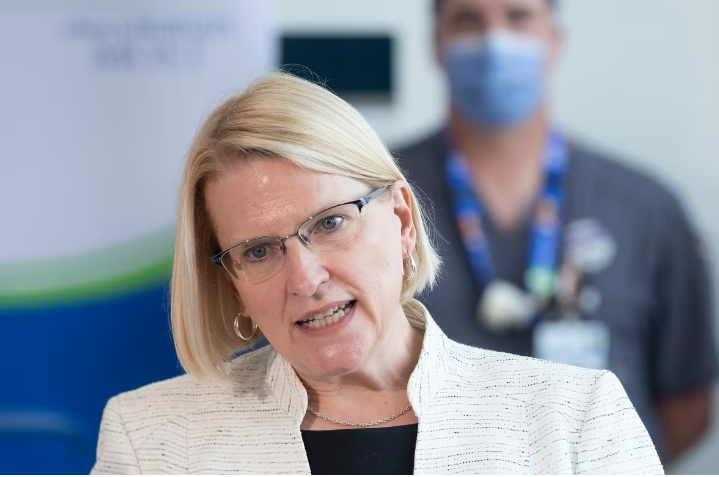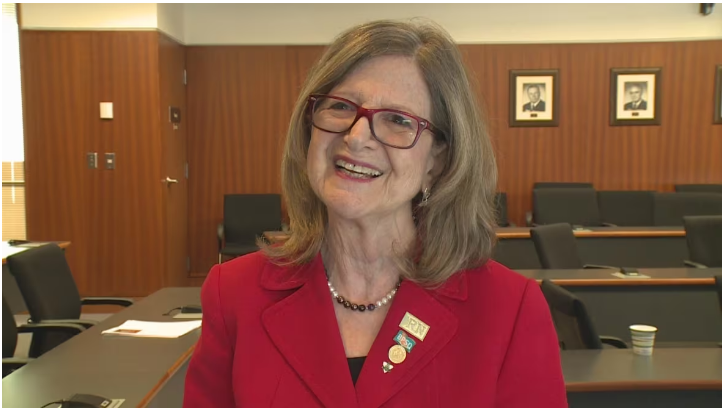
Paramedics unload patients from ambulances at the emergency department of a Toronto hospital. (Evan Mitsui/CBC)
Several Ontario municipalities say their paramedic services are under immense pressure, with worrying stretches of times during which no ambulances are available to respond to calls — but the province doesn’t track the problem.
The government does have data on the hours paramedics spend waiting in emergency rooms to transfer patients to the care of a hospital, which are often a key factor in ambulance availability, but won’t disclose it.
Some emergency officials and community leaders say more needs to be done to help paramedic services, but the lack of publicly available provincial information makes it hard to assess the scope of the problem.
“We just want to be able to have a baseline to say, ‘Oh, things have improved since 2020, since 2018,’ and being able to quantify the data so that when we do go to the province, or to our employers, we want to be able to go with solutions,” said Niko Georgiadis, chair of the CUPE Ambulance Committee of Ontario.
Ambulance dispatch centres are mostly operated by the province, so they should be keeping track of how often there are no ambulances available — situations known as code zero or code black — said Georgiadis.
A spokesperson for Health Minister Sylvia Jones said the province doesn’t track that because municipalities are responsible for ambulance deployment strategies.
Ontario generates monthly reports based on data from ambulance dispatch centres, including time paramedics spend waiting in ERs to transfer patients — known as offload delays — by hospital. But requests for the figures, including a specific request for the most recent report went unacknowledged.

Ontario Health Minister Sylvia Jones, shown during a 2022 announcement at Toronto’s Sunnybrook Hospital, says the province has implemented and expanded various programs to address ambulance availability issues. (Chris Young/The Canadian Press)
Jones has implemented and expanded various programs to address ambulance availability issues, from increasing funding for nurses to monitor ambulance patients so paramedics can get back on the road, to allowing paramedics to take patients somewhere other than an ER.
“Our government’s four-part strategy to tackle ambulance offload time issues is focused on: returning ambulances to communities faster, providing timely and appropriate care in the community, facilitating non-ambulance transportation for stable patients, and increasing health care worker capacity,” spokesperson Hannah Jensen wrote in a statement.
Several communities say offload delays and the lack of ambulance availability skyrocketed from 2021 to 2022. Some say it’s looking a bit better for 2023, but more needs to be done.
Essex-Windsor EMS Chief Bruce Krauter has been combing through his own region’s data, and found that from January to May, code blacks and code reds — when there were either no ambulances or one or two — tended to happen between 3 p.m. and 11 p.m.
He ties that to the lack of availability of urgent care clinics and primary care during those hours, and has asked Jones to fund those services for extended hours.
“If we get some better urgent care, primary care, those code reds and blacks should come down,” he said.
Jones’s spokesperson said the minister is working with health-care leaders in that region on “innovative solutions” to increase ambulance availability.
The County of Essex declared an emergency in the fall due to long offload delays and code reds and blacks. On one day preceding the declaration there were no ambulances available for almost three hours as 26 paramedic teams were delayed at hospitals.
There has been some improvement since then, Krauter said. In October there were a total of 629 minutes during which no ambulance was available. In May that total was 173 minutes. But the local emergency remains in place until there are no more code reds or blacks, Krauter said.
More funding from the province for dedicated offload nurses — who can manage ambulance patients in the ER so paramedics can get back on the road — has helped, Krauter said, as has EMS putting a “navigator” into the dispatch centre to help direct movement of ambulances.
Reprioritizing ambulance calls under a new dispatch algorithm is also expected to help, Krauter said.
“Right now if you call for 911 … and you say, ‘Hello, I hit my nose on something and it’s bleeding,’ you automatically get an ambulance, lights and sirens to your house,” he said.
“We’re over-responding to calls and all that does is drain resources.”
In hospitals, Doris Grinspun, CEO of the Registered Nurses’ Association of Ontario, said even with the increased funding for dedicated offload nurses — $51 million extra over three years — the money can’t always be put to use because of general nursing staff shortages.
The health minister’s spokesperson noted the province expanded that program last year to allow paramedics, physician assistants and respiratory therapists to assist.

Doris Grinspun, CEO of the Registered Nurses’ Association of Ontario, says ambulance dispatch centres are mostly operated by the province so should be keeping track of how often there are no ambulances available. (Amy Dodge/CBC)
Ottawa Mayor Mark Sutcliffe has asked the province to pay for 51 new paramedics to act as offload paramedics. Normally, paramedics are funded 50-50 by the province and municipalities, but Sutcliffe argues offload delays are a provincial responsibility.
Last year, Ottawa’s paramedic service spent 93,686 hours in offload delays. In Toronto, that number was about 300,000 hours, according to a paramedic services report.
In Waterloo Region, the amount of time no ambulances were available increased by 571 per cent from 2021 to 2022.
Offload delays are a factor, as are an increase in call volumes and paramedic staff shortages, said John Riches, chief of paramedic services.
The region has increased ambulance resources and 2023 is so far looking a little better, he said, but it’s “not significant enough to celebrate.”
Waterloo Region paramedics and its three area hospitals are hoping to introduce a “fit to sit” program this fall, in which paramedics can leave certain stable patients to wait in the ER, he said.
Hospitals in Durham Region have such a program, and that along with additional offload nurse funding has helped dramatically ease offload delays and code zeros, said paramedic services chief Troy Cheseboro.
Over the past couple of years it wasn’t uncommon to have offload delays of four hours, and now most are under 60 or 90 minutes, Cheseboro said.
“We’re seeing huge, huge changes with the work the hospital has done to try to mitigate some of these added pressures,” he said.
Cheseboro said Durham has also seen great success with the community paramedicine program, which sees them provide in-home care and outreach to frequent callers and those who need help with chronic disease management. He would like to see stabilized funding for it beyond the current 2026 commitment.
People who call for an ambulance in Ontario may have to wait longer for one to arrive as health-care staffing shortages and recent temporary emergency room closures slow down emergency services’ response, a paramedics’ group said Friday.
Ambulance offload delays — when paramedics wait in an emergency department for a patient to be transferred to the care of a hospital — are tying up paramedics for longer and longer, preventing them from responding to calls during that time, said Michael Sanderson of the Ontario Association of Paramedic Chiefs.
“Not only does it slow the response to emergency calls, in other words, the life-threatening calls, the heart attacks, strokes, major trauma,” it also means there are fewer ambulances available to respond to calls for broken bones and other less critical conditions, said Sanderson, who co-chairs the association’s working group on offload delays.
Stretches of time when there are no ambulances available to respond to calls — known as “code zero” events — are also growing more frequent, he said.
Sanderson, who is chief of the Hamilton Paramedic Service, said the city has seen 196 so-called “code zero” events so far this year, more than double the tally for all of last year. “And it’s probably headed towards the worst year that we’ve had,” he added.
Darryl Wilton, president of the Ontario Paramedic Association, said in a recent interview that offload delays have gotten 12 times longer in the last year alone.
Wilton said the delays have reached a level he has never seen before in his 25 years on the job.
Offload delays of one to two hours were previously considered extreme, but now some patients and paramedics are waiting 10 to 15 hours, he said.
“A patient could be picked up this afternoon and not be offloaded until sometime tomorrow morning, and that’s not unusual anymore,” he said. That means multiple paramedic crews may be caring for the same patient over several shifts, he added.
The worsening delays are “having a massive impact on paramedic availability,” and the effects ripple out through neighbouring communities, Wilton said.
“This is something that, plain and simple, requires beds and staff to fix the problem,” he said.
Ontario Health Minister Sylvia Jones said in a statement Friday that the province has added more than 10,500 health-care workers to the system since the start of the COVID-19 pandemic.
“Like many other jurisdictions around the world, Ontario’s health system faces pressures due to the challenge of maintaining the required staffing levels,” she said.
“We have been working proactively with all partners, including Ontario Health and the 140 hospital corporations, the regulatory colleges, and health sector unions, to address these staffing pressures. This includes identifying solutions for both the short and long term.”
The Ministry of Health said the government’s most recent budget included $7 million in additional funding for a program that brings in health-care workers to help transfer ambulance patients to hospital care. The budget was presented in April but did not pass before the June election.
Neal Roberts, chief of the Middlesex-London Paramedic Service and past president of the OAPC, said staffing shortages across the health-care sector, combined with the recent temporary hospital closures and a slight uptick in calls for paramedic care have created “almost like a perfect storm and a bit of a domino (effect).”
The closures force paramedics to take patients to hospitals farther away, which takes more time and reduces service in their community, he said in a recent interview. It also places more strain on the hospitals where those patients are taken, contributing to delays and bottlenecks there, he said.
Just as hospitals are seeing shortages in nurses and doctors, paramedic services have also been stretched thin due to increased demand and the expansion of their duties during the pandemic, he said.
“We’ve hired upwards of, I think, 50-odd staff this year and we still could hire more,” he said. “It’s just the more we hire, the more we need — and we’re just seeing this across all health care.”
Some hospitals — including Lakeridge Health’s Bowmanville hospital and the Seaforth Community Hospital in Huron County — have announced closures or reduced hours ahead of the long weekend.
Several Ontario hospitals have previously warned that emergency department closures could be a recurring issue this summer as a result of staffing shortages. Rural areas have been particularly affected, with communities such as Perth, Clinton and Wingham seeing their ERs close for stretches as long as several days.
Offloading delays predate the COVID-19 pandemic but paramedics’ groups say the issue has gotten worse during the health crisis.
Earlier this year, the Ontario government issued a memo to emergency services, telling them to consider having paramedic crews tend to more than one patient at a time in ERs — something known as “batching” patients — so that paramedics could return to service more quickly.
Demand Transparency from Authorities: Advocate for greater transparency in ambulance response times and offload delays. Encourage the province to release the data to the public, fostering accountability and informed decision-making.
Invest in Ambulance Resources: Highlight the urgent need for increased funding and resources for ambulance services. Emphasize the importance of investing in personnel, vehicles, and medical equipment to meet growing demands.
Prioritize Emergency Medical Training: Stress the significance of continuous training for emergency medical personnel to enhance their skills and improve response times in critical situations.
Strengthen Collaboration: Call for stronger collaboration between ambulance services, hospitals, and government agencies to streamline patient handoffs and reduce offload delays.
Raise Public Awareness: Encourage public awareness campaigns about when to call an ambulance, promoting alternatives for non-life-threatening situations and ensuring the public can make informed decisions.
Advocate for Policy Reform: Push for policy reforms at the provincial level to address underlying issues causing ambulance pressures, such as wait times in emergency departments and overcrowded hospitals.

